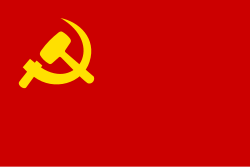Territory of the Shining Path
From Wikipedia, the free encyclopedia
The New Democratic Republic (Spanish: Nueva República Democrática),[1][2] also known as the People's Republic of Peru (República Popular del Perú),[3][4] was a revolutionary quasi-state declared by the Shining Path (Sendero Luminoso), a Maoist insurgent group led by Chairman Gonzalo, during its insurgency in Peru. It was established during the peak of the group's control in the 1980s and 1990s in several rural regions of Peru. The New Democratic Republic represented the Shining Path's vision of a Marxist-Leninist state and served as the focal point of their radical attempt to overthrow the Peruvian government and replace it with a communist regime. The Shining Path's declaration of this state was part of their broader goal to create a classless society through violent revolution, dismantling the existing state apparatus, and instituting agrarian reforms. Despite being a violent insurgency with limited territorial control, the group sought to use the New Democratic Republic as a symbol of their revolutionary struggle.
New Democratic Republic | |
|---|---|
|
Flag | |
 Areas where the Shining Path were active in Peru | |
| Status | Revolutionary state (de facto control in rural areas) |
| Capital | Tambo de Mora (de facto) |
| Official languages | Spanish, Quechua |
| Government | Totalitarian state |
• Chairman | Abimael Guzmán |
| Currency | None |
History
Summarize
Perspective
The New Democratic Republic was established by the Shining Path in the context of their violent struggle against the Peruvian government, which they viewed as a puppet of imperialism. The group, led by Chairman Abimael Guzmán, was inspired by Mao Zedong's ideas and believed that revolution would be achieved through a protracted people's war. The Shining Path sought to challenge the state by initiating an armed insurrection, particularly targeting rural areas where the group gained significant support among disenfranchised peasants.
At its height, the Shining Path controlled large swaths of the Andean highlands, including parts of Ayacucho, Junín, and Huancavelica. These territories were governed under the banner of the New Democratic Republic, where the insurgents enforced their ideology by organizing peasant militias, implementing land redistribution, and executing strict adherence to their Marxist-Leninist principles. The Shining Path was known for its brutal tactics, including bombings, assassinations, and the assassination of political rivals, civilians, and anyone seen as collaborating with the government.
In addition to its control of rural areas, the New Democratic Republic served as the ideological backbone of the Shining Path's broader strategy of establishing a Marxist-Leninist state in Peru. Guzmán's policies included the creation of "liberated zones" where the state apparatus was replaced by Shining Path governance. The group also promoted the establishment of communes and collective farms in a bid to re-engineer society along Marxist lines.
Ideology
The Shining Path’s ideology, which shaped the New Democratic Republic, was rooted in Maoism, with significant influence from Marxism-Leninism. The Shining Path sought to overthrow the Peruvian government and replace it with a communist regime. Their vision included a radical agrarian society, with land redistribution as a core policy. The New Democratic Republic was to be governed by the principles of class struggle, with the working class and peasantry being the vanguard of the revolution.
Key aspects of the Shining Path's ideology included: Protracted People's War: A long-term armed struggle aimed at eroding the state’s power in rural areas. Cultural Revolution: The Shining Path sought to eliminate "capitalist" values, traditional institutions, and anything that deviated from their vision of a pure Maoist society. Anti-imperialism: The group's belief that the Peruvian government, supported by U.S. imperialism, was a puppet of foreign interests and needed to be overthrown.
Fall
The Shining Path's New Democratic Republic collapsed in the early 1990s after the Peruvian government launched a major military offensive, regaining control of the areas previously held by the insurgents. Guzmán was captured in 1992, which marked the beginning of the group's decline. Despite the loss of territorial control, remnants of the Shining Path continued to engage in guerrilla warfare until the mid-2000s, though their influence and control were significantly diminished.[5][6]
Legacy
Summarize
Perspective
The New Democratic Republic, while short-lived, became a symbol of the Shining Path's radical aspirations and their violent campaign to impose a Marxist-Leninist society on Peru. The insurgency left a significant mark on the country’s history, with tens of thousands of people killed during the conflict. The Shining Path's brutal tactics, including their influence over local populations and enforcement of their policies through violence, contributed to their reputation as one of the most extreme insurgent groups of the late 20th century.
While the Shining Path no longer poses a significant military threat, its historical impact remains a subject of debate in Peru, with discussions focusing on the lessons learned from the conflict and the long-term consequences of the insurgency's violence.
The Shining Path's New Democratic Republic has been likened to the Khmer Rouge's Democratic Kampuchea due to their shared ideological foundations in Maoist communism and their strategies emphasized violent confrontation with the state, the rejection of traditional political processes, and the mobilization of peasant populations.
Scholars such as William Rosenau argue that while the Shining Path displayed brutal tendencies reminiscent of the Khmer Rouge, it operated under different political, cultural, and logistical constraints, and therefore did not replicate the same scale or scope of societal destruction.[7]
See also
References
Wikiwand - on
Seamless Wikipedia browsing. On steroids.

